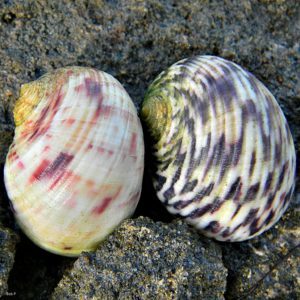Nerites
It’s story time again here, and this week’s installment comes from one of my very favorite Greek myths.
I wouldn’t be surprised if most people haven’t heard of Nerites. He didn’t make it into Edith Hamilton’s seminal work on Greek mythology, and though he earned a Wikipedia entry, it’s pretty sparse. According to the Theoi Project, a comprehensive glossary of mythological figures, his story comes from the Greek historian Aelian (c. 2 A.D.) who wrote about how a spiral shell of exceptional beauty came to be called a nerite. He claimed the story was well-known among sailors.

Nerite shells, image retrieved from Wikipedia commons
Aelian told the story thusly: Nerites was the son of Nereus, a sea-god, sometimes referred to as the Old Man of the Sea, and Doris, a river goddess who was the daughter of the titan Oceanus. Nereus and his sea nymph daugthers the Nereids were previously noted by several of Aelian’s predecessors. Homer mentions Achilles’ mother Thetis as a Nereid, as is Calypso from The Odyssey, for example. There are said to be fifty Nereids, but only one Nerites, which was one of the curiosities that led me to retell a little story about him. What would it be like to grow up with fifty sisters?
After that brief introduction, Aelian tells two different versions of Nerites’ tale. Both involve Aphrodite and Poseidon, but the outcome of their dealings with Nerites differ.
Both versions say Nerites was a beautiful youth beyond compare (among many other young heartthrobs like Ganymede and Narcissus in fact), and he attracted the interest of Aphrodite who offered him wings if he would be her lover. Nerites refused the goddess, and to put him in his place, Aphrodite turned him into a snail.
Nerites’ sisters begged the god Poseidon to change him back, and he obliged. The mighty sea god was smitten from the sight of the boy, and he offered to make him his charioteer. Nerites agreed, and Aelian says they lived together happily ever after as companions and lovers, even mentioning that the word for mutual, requited love – anteros – derives from Poseidon and Nerites’ love affair.
I thought that was sweetly sentimental and refreshing. I can’t recall any stories of things going well when a god falls in love with a mortal, or a demi-god. In most cases their love interest is forcibly taken. So it goes with the most famous same-sex myth about Zeus and Ganymede, and in others, like Apollo and Hyacinth, the mortal ends up getting killed.
Well, that’s one version. Aelain also recounts a different story in which Aphrodite isn’t the villain, but it’s the god Helios who was jealous, either because he didn’t like Nerites challenging his notoriety for driving a magical chariot, or because the beautiful boy couldn’t be coerced to serve him. So Helios turned Nerites into a snail.
I like the other version better. 



